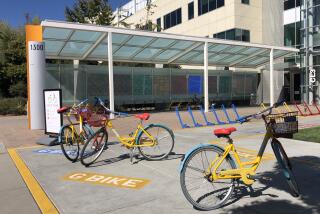Schools Need More Brain, Not Machine, Power
- Share via
I have read with interest the opinions of Michael Schrage (“The Networks of Educational Hell Are Wired With Good Intentions,” Board of Advisors, Oct. 8) and Lewis Solmon (“Wiring Up Classrooms Can Help to Get Students’ Future Online,” Sunday Forum, Nov. 12) regarding the benefits of wiring every classroom in the country to the Internet and, more generally, the role of technology in the classroom.
As a physicist educated in Europe and the U.S.--with many years’ experience in the fields of physics and applied mathematics and who recently met the requirements for a secondary-school teaching credential--I would like to share some of my thoughts on the subject.
Educators seem to agree that U.S. high school students’ training in mathematics and the sciences has fallen behind that of students from the developed nations to which we compare ourselves.
It is my understanding that Mr. Solmon believes that wiring the classroom to the Internet will go a long way toward turning out better-trained and more knowledgeable students. Mr. Schrage is, on the other hand, very critical of the value of this technology in education. He feels that it could be potentially destructive to educational improvement efforts in the U.S.
I lend my strong support to Mr. Schrage’s view for the following reasons:
The Internet provides access to vast sources of information today and will, no doubt, provide virtually unlimited access to information in the future. Without dwelling on concerns about the quality of information available (which certainly will receive increasing attention), let us ask the question: Is availability of information a problem in our schools today?
Drawing from my experiences with high school and the subjects of mathematics and the sciences, I maintain that the problems we see today are related to the lack of ability to retain, process and apply the skills taught, not a lack of information itself. For example, at the high school level, the information that is required is contained in a limited number of basic textbooks with only a limited need for information updates.
What is required today, as in the past, is a positive learning environment and the opportunity and willingness of the student to spend the time and effort necessary to acquire the skills and practice using these skills. A good learning environment requires good teachers (which, by and large, we have), small classes (of fewer than about 25 students, which we do not have), and parent-guardian involvement and supervision to ensure follow-up after school. TV watching (ironically, another source of “information”) is, with a few exceptions, inconsistent with learning.
Personal computers are certainly important to the study of certain branches of mathematics. However, a weekly computer lab should be sufficient, provided the students are introduced to computers at an early age. A large-screen TV and a VCR (which many classrooms have today) provide, in my opinion, the technology required to visualize concepts in science and otherwise bring the world into the classroom.
I believe that most countries with math and science education superior to ours do not have much in terms of stand-alone or networked computers. I also believe that these countries teach fundamentals based on tested, proven techniques and materials without the distraction and confusion caused by educational experiments such as the “new math” of the ‘70s and the “new, new math” (a.k.a. “interactive math”) of the ‘90s.
In conclusion, I believe that our educational problems are not linked to lack of information, but rather to information overload combined with our inability to provide a first-rate learning environment. Smaller classes would benefit students far more than a computer on each desk.
PAAL K. BAKSTAD
Rancho Palos Verdes
More to Read
Sign up for Essential California
The most important California stories and recommendations in your inbox every morning.
You may occasionally receive promotional content from the Los Angeles Times.













